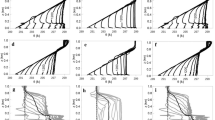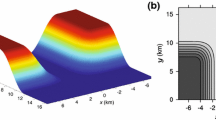Abstract
We quantify the impact of a valley-wind system on the transport of passive tracers in the stably-stratified atmosphere of a valley dynamically decoupled from the atmosphere above. The simple configuration of an idealized Alpine-type valley opening onto a plain is considered, for two values of the initial buoyancy frequency and of the valley steepness. The valley-wind system consists of thermally-driven downslope flows that induce a pressure difference between the valley interior and the plain, thereby triggering a down-valley flow. A steady-state regime is eventually reached, at the beginning of which passive tracers are emitted at the valley floor and at different heights above it. The tracer emitted at the valley floor is fully mixed below the height of the maximum speed of the down-valley flow, which behaves like a jet, and remains decoupled from the tracers emitted above. The down-valley flow increases linearly in the along-valley direction y so that, from the conservation of tracer flux, the tracer concentration decays as 1 / y. A simple theoretical model is proposed to fully account for the down-valley flow and tracer behaviour. The tracer concentration emitted at the valley floor also displays marked oscillations, induced by internal gravity waves radiated via a hydraulic-jump process when the downslope flow reaches the valley floor. The amplitude of the oscillations can be as high as 50% of their mean value, implying that averaged values in an urbanized valley may disguise high instantaneous—and potentially harmful-values.















Similar content being viewed by others
References
Anquetin S, Guilbaud C, Chollet JP (1999) Thermal valley inversion impact on the dispersion of a passive pollutant in a complex mountainous area. Atmos Environ 33(24):3953–3959
Arduini G, Staquet C, Chemel C (2016) Interactions between the nighttime valley-wind system and a developing cold-air pool. Boundary-Layer Meteorol 161(1):49–72
Arduini G, Chemel C, Staquet C (2017) Energetics of deep alpine valleys in pooling and draining configurations. J Atmos Sci 74(7):2105–2124
Banta RM, Pichugina YL, Newsom RK (2003) Relationship between low-level jet properties and turbulence kinetic energy in the nocturnal stable boundary layer. J Atmos Sci 60(20):2549–2555
Beychok M (1995) Fundamentals of stack gas dipersion. In: Beychok MR (ed), Irvine, California
Brulfert G, Chemel C, Chaxel E, Chollet J (2005) Modelling photochemistry in alpine valleys. Atmos Chem Phys 5(9):2341–2355
Burns P, Chemel C (2014) Evolution of cold-air-pooling processes in complex terrain. Boundary-Layer Meteorol 150(3):423–447
Chemel C, Burns P (2015) Pollutant dispersion in a developing valley cold-air pool. Boundary-Layer Meteorol 154(3):391–408
Chemel C, Staquet C, Largeron Y (2009) Generation of internal gravity waves by a katabatic wind in an idealized alpine valley. Meteorol Atmos Phys 103(1–4):187–194
Cuxart J, Jiménez M (2007) Mixing processes in a nocturnal low-level jet: an les study. J Atmos Sci 64(5):1666–1679
Deardorff JW (1980) Stratocumulus-capped mixed layers derived from a three-dimensional model. Boundary-Layer Meteorol 18(4):495–527
Drazin P, Reid W (1982) Hydrodynamic stability. Cambridge University Press, Cambridge
Dudhia J (1989) Numerical study of convection observed during the winter monsoon experiment using a mesoscale two-dimensional model. J Atmos Sci 46:3077–3107
Jiménez PA, Dudhia J, González-Rouco JF, Navarro J, Montávez JP, García-Bustamante E (2012) A revised scheme for the wrf surface layer formulation. Mon Weather Rev 140(3):898–918
Klemp J, Dudhia J, Hassiotis A (2008) An upper gravity-wave absorbing layer for nwp applications. Mon Weather Rev 136(10):3987–4004
Lang M, Gohm A, Wagner J (2015) The impact of embedded valleys on daytime pollution transport over a mountain range. Atmos Chem Phys 15(20):11,981–11,998
Lareau NP, Crosman E, Whiteman CD, Horel JD, Hoch SW, Brown WO, Horst TW (2013) The persistent cold-air pool study. Bull Am Meteorol Soc 94(1):51–63
Largeron Y, Staquet C (2016) The atmospheric boundary layer during wintertime persistent inversions in the Grenoble valleys. Front Earth Sci 4:70
Lehner M, Gohm A (2010) Idealised simulations of daytime pollution transport in a steep valley and its sensitivity to thermal stratification and surface albedo. Boundary-Layer Meteorol 134(2):327–351
McNider RT (1982) A note on velocity fluctuations in drainage flows. J Atmos Sci 39(7):1658–1660
Mlawer EJ, Taubman SJ, Brown PD, Iacono MJ, Clough SA (1997) Radiative transfer for inhomogeneous atmospheres: RRTM, a validated correlated-k model for the longwave. J Geophys Res 102:663–682
Peckham SE, Grell GA, McKeen SA, Barth M, Pfister G, Wiedinmyer C, Fast JD, Gustafson WI, Ghan SJ, Zaveri R, et al. (2012) WRF/Chem Version 3.3 User’s Guide. US Department of Commerce, National Oceanic and Atmospheric Administration, Oceanic and Atmospheric Research Laboratories, Global Systems Division
Prandtl L (1952) Essentials of fluid dynamics: with applications to hydraulics, aeronautics, meteorology and other subjets (English translation). Blackie & Son
Rampanelli G, Zardi D, Rotunno R (2004) Mechanisms of up-valley winds. J Atmos Sci 61(24):3097–3111
Rendón AM, Salazar JF, Palacio CA, Wirth V, Brötz B (2014) Effects of urbanization on the temperature inversion breakup in a mountain valley with implications for air quality. J Appl Meteorol Climatol 53(4):840–858
Renfrew IA (2004) The dynamics of idealized katabatic flow over a moderate slope and ice shelf. Q J R Meteorol Soc 130:1023–1045
Schmidli J, Rotunno R (2015) The quasi-steady state of the valley wind system. Front Earth Sci 3:79
Scotti A, Meneveau C, Lilly DK (1993) Generalized smagorinsky model for anisotropic grids. Phys Fluids A Fluid Dyn (1989–1993) 5(9):2306–2308
Silcox GD, Kelly KE, Crosman ET, Whiteman CD, Allen BL (2012) Wintertime pm 2.5 concentrations during persistent, multi-day cold-air pools in a mountain valley. Atmos Environ 46:17–24
Wagner J, Gohm A, Rotach M (2014) The impact of valley geometry on daytime thermally driven flows and vertical transport processes. Q J R Meteorol Soc 141(690):1780–1794
Whiteman CD, Pospichal B, Eisenbach S, Weihs P, Clements CB, Steinacker R, Mursch-Radlgruber E, Dorninger M (2004) Inversion breakup in small rocky mountain and alpine basins. J Appl Meteorol 43(8):1069–1082
Whiteman CD, Hoch SW, Horel JD, Charland A (2014) Relationship between particulate air pollution and meteorological variables in utah’s salt lake valley. Atmos Environ 94:742–753
Zardi D, Whiteman CD (2013) Diurnal mountain wind systems. In: Chow FK, De Wekker SF, Snyder BJ (eds) Mountain weather research and forecasting: recent progress and current challenge. Springer, Berlin, pp 35–119
Acknowledgements
The PhD work of J. Quimbayo is supported by the Colombian Administrative Department of Science, Technology and Innovation (COLCIENCIAS). Numerical simulations were run on the French national HPC facilities at CINES.
Author information
Authors and Affiliations
Corresponding author
Additional information
Publisher's Note
Springer Nature remains neutral with regard to jurisdictional claims in published maps and institutional affiliations.
Rights and permissions
About this article
Cite this article
Quimbayo-Duarte, J., Staquet, C., Chemel, C. et al. Dispersion of Tracers in the Stable Atmosphere of a Valley Opening onto a Plain. Boundary-Layer Meteorol 172, 291–315 (2019). https://doi.org/10.1007/s10546-019-00439-2
Received:
Accepted:
Published:
Issue Date:
DOI: https://doi.org/10.1007/s10546-019-00439-2




